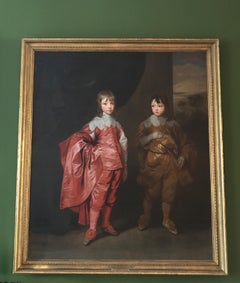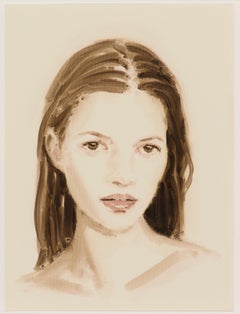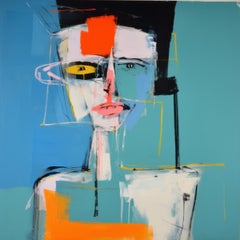(After) Anthony Van Dyck Paintings
Dutch, 1599-1641
Sir Anthony van Dyck (22 March 1599 – 9 December 1641) was a Flemish Baroque artist who became the leading court painter for Charles I of England. Sir Anthony Van Dyck was born in the Netherlands and painted from an early age becoming a successful independent painter in his late teens, and a master in the Antwerp Guild in 1618. He painted in the studio of Peter Paul Rubens who became a major influence on his work. Van Dyck worked in London for some months in 1621, then returned to Flanders and travelled to Italy, where he stayed until 1627, mostly in Genoa. He spent five years in Flanders after his return from Italy, and was court painter for the archduchess Isabella, Habsburg Governor of Flanders. In 1632 he returned to London to become the main court painter to Charles I of England.
After Holbein, van Dyck and his contemporary Diego Valezquez were the first painters of pre-eminent to work mainly as court portraitists, revolutionising the genre. Van Dyck is best known for his portraits of the royals and aristocracy, most notably Charles I, and his family and associates. Van Dyck widely influenced English portrait painting for the next 150 years. His portrait style changed considerably between the different countries he worked in, culminating in the relaxed elegance of his last English period. His influence extends into the modern period. During his lifetime, Charles I granted him a knighthood, and after his death Van Dyck was buried in St Paul’s Cathedral, an indication of his high standing at the time of his death.to
2
1
1
Overall Width
to
Overall Height
to
2
1
2
1
1
1
1
1
3
783
709
702
697
1
1
2
Artist: (After) Anthony Van Dyck
Double Portrait Oil Painting Brothers George, 2nd Duke Buckingham & Lord Francis
By (After) Anthony Van Dyck
Located in London, GB
Aftrer Anthony VAN DYCK - maybe Studio (1599, Antwerp – 1641, London) Flemish
Double Portrait of George Villiers, 2nd Duke of Buckingham (1628-1687) & Lord Francis Villiers (1629-1648)
Oil on Canvas
170 x 147 cm
Anthony Van Dyck (1599-1641)
No painter has done more to define an era than Anthony van Dyck. He spent only seven and a half years of his short life (1599- 1641) in England. He grew up in Antwerp, where his precocious talent was recognised by Peter Paul Rubens, the greatest painter of his age. He worked in Rubens’s studio and imitated his style as a religious artist, painting biblical scenes redolent of the lush piety of the counter-reformation. But soon he was on the move. In 1620, he visited London for a few months, long enough to paint a history picture, The Continence of Scipio, for the royal favourite, George Villiers, Marquess of Buckingham, and a portrait of his other English patron, the great art collector, Thomas Howard, 2nd Earl of Arundel.
After a stint in Italy, making imposing portraits of the wealthy aristocracy and sketching and copying works by Titian, he returned to the Spanish Netherlands in 1627, becoming court artist to Archduchess Isabella before departing for The Hague in 1631 to paint the Dutch ruler Frederick Henry, Prince of Orange. Charles I’s invitation in 1632 led Van Dyck back to London where he was knighted, paid an annual salary of £200 and installed in a house in Blackfriars with a special jetty at which the royal barge might tie up when the King was visiting his studio. By this time Van Dyck was recognised as the leading court painter in Europe, with Velazquez at the court of Philip IV of Spain his only rival. He also excelled as a superbly observant painter of children and dogs.
Van Dyck’s notoriety in depicting children led to the introduction of groups of children without their parents as a new genre into English painting (amongst other new genres).
For the next 300 years, Van Dyck was the major influence on English portraiture. Nearly all the great 18th Century portraitists, from Pompeo Batoni and Allan Ramsay to Thomas Gainsborough and Joshua Reynolds, copied Van Dyck’s costumes, poses and compositions.
George Duke of Buckingham & his brother Francis Villiers
Painted in 1635, this double portrait was originally commissioned by Charles I, who raised the two brothers after their father, George Villiers, was assassinated in 1628. Together with their sister, Lady Mary Villiers, they enjoyed the King’s favour absolutely. Francis whose absolute ‘inimitable handsomeness’ was noted by Marvell (who was killed in a skirmish near Kingston upon Thames). The young duke who commanded a regiment of horse at the Battle of Worcester, remained closely associated with Charles II, held a number of high offices after the Restoration and was one of the most cynical and brilliant members of the King’s entourage, immortalised as ‘Zimri’ in Dryden’s Absalom and Achitopbel. As a young man he had sold his father’s great collection of pictures in the Spanish Netherlands, many of them to the Archduke Leopold Willhelm.
Painted for Charles I and placed near the portrait of their sister in the Gallery at St James’ Palace. The handling of both costumes is very rich, and the heads are very carefully and sensitively worked. That of the younger boy in particular is more solidly built up than the lower part of the figure. A preparatory drawing for the younger boy is in the British Museum.
There are copies at, e.g., Highclere Castle...
Category
17th Century Old Masters (After) Anthony Van Dyck Paintings
Materials
Oil
Anthony van Dyck, Engraving Ernest de Mansfeld, c. 1654, Portrait, Iconographie
By (After) Anthony Van Dyck
Located in Greven, DE
A wonderfully detailed and charismatic portrait, this exquisite work illustrates the technical mastery and artistic vision of Van Dyck. Ernest de Mansfeld's stately yet approachable expression reflects Van Dyck's refined ability to comfort and relax his subjects, resulting in a realistic and acute portrait. Ernest de Mansfeld was a German military commander during the early years of the Thirty Years War. Donning his armor and an ornate, lace collar, de Mansfeld appears as a strong commander. Without a hint of a smile, he calmly gazes out, the definition of cool and collected. Van Dyck accurately captures the sense that de Mansfeld is a man who takes his job seriously, a man worthy of commanding an army in battle.
This portrait is a Mauquoy-Hendrickx State II (of II), engraved by Robertus van Voerst in collaboration with Anthony van Dyck (Antwerp, 1559 - London, 1641) as part of his Iconographie series of engraved portraits of famous people...
Category
17th Century Baroque (After) Anthony Van Dyck Paintings
Materials
Engraving, Laid Paper
Related Items
Kate Moss
By Annie Kevans
Located in New York, NY
Listing includes framing, free shipping to continental US and a 14-day return policy.
Kate Moss by Annie Kevans
20 x 16 inch paper
16 x 20 inch image
Archival pigment print
Edition 15 of 50
Signed and edition on the front of the print
Frame is in fair condition and is included for free due the condition issues. The print itself is in excellent condition. If you would like the print sent unframed the cost is the same. Please let us know if you would prefer to have us ship the print unframed.
Artist Biography -
Kevans’ paintings reflect her interests in power, manipulation and the role of the individual in inherited belief systems. She looks at alternative histories and how they relate to current issues and creates what she describes as ‘anti-portraits’ that may or may not be based on real documentation. She believes that, as her work is concept driven, sometimes the actual similarity to the person depicted in the work is irrelevant. This can be seen in her 'Boys' series which is not about portraying dictators as they really looked as children but rather about the notion of the ‘innocent child’ which has influenced images of children in art...
Category
2010s Contemporary (After) Anthony Van Dyck Paintings
Materials
Canvas, Archival Paper, Archival Pigment
Human Faces Abstract Collection - HFC 9 - Limited Edition Textured Canvas Print
By Irena Orlov
Located in Los Angeles, CA
Human Faces Abstract Collection - HFC 9 - Limited Edition Textured Canvas Print
Faces Abstract Collection by Irena Orlov
Introducing "Abstract Cubist Portrait - Human Faces Abstrac...
Category
2010s Cubist (After) Anthony Van Dyck Paintings
Materials
Canvas, Paint, Cotton Canvas, Mixed Media, Acrylic, Digital, Inkjet, Giclée
$3,120 Sale Price
20% Off
H 45 in W 45 in D 2 in
King Richie, Street Art, Pop Art,
By Jay-C
Located in München, BY
Edition 5
Richie Rich as King
JAY-C – the pseudonym of this innovative young artist known for his subversive use of familiar figures and symbols. Using a distinct and fine British s...
Category
2010s Pop Art (After) Anthony Van Dyck Paintings
Materials
Mixed Media, Pigment, Archival Pigment
Angelic Cherubs with Classical Figure in Wilderness Finely Painted Preparatory
Located in Cirencester, Gloucestershire
Figure with Cherubim in Wilderness
Italian School, 17th century
oil painting on wood panel
framed 13 x 11 inches
condition: overall for its age very good, though the work is most likely a preparatory...
Category
17th Century Old Masters (After) Anthony Van Dyck Paintings
Materials
Oil, Wood Panel
$3,573
H 13 in W 11 in D 1 in
Early 1800's Italian Oil Painting Portrait of Bearded Man Saint Peter Apostle
Located in Cirencester, Gloucestershire
Italian School, early 19th century
'Portrait of a Bearded Man' - possibly Saint Peter?
oil on board, framed
framed: 16 x 13.5 inches
board: 12.5 x 9.5 inches
provenance: private col...
Category
Early 19th Century Old Masters (After) Anthony Van Dyck Paintings
Materials
Oil
Fine 18th Century British Oil Painting Mother & Infant Child in Adoration
Located in Cirencester, Gloucestershire
Mother & Child
British artist, late 18th century
after the painting by Sir Anthony van Dyke
oil on canvas, unframed
canvas : 20 x 18 inches
provenance: private collection, Berkshire,...
Category
18th Century Old Masters (After) Anthony Van Dyck Paintings
Materials
Oil, Canvas
Timeless classic, Street Art, Pop Art, bust
By Jay-C
Located in München, BY
Edition 5
A bust in Street art style
JAY-C – the pseudonym of this innovative young artist known for his subversive use of familiar figures and symbols. Using a distinct and fine Br...
Category
2010s Street Art (After) Anthony Van Dyck Paintings
Materials
Mixed Media, Pigment, Archival Pigment
Huge Antique Dutch Old Master Oil Painting The Jewish Bridge after Rembrandt
Located in Cirencester, Gloucestershire
The Jewish Bridge
antique Dutch School, after the 1660's oil painting by Rembrandt (Rijksmuseum, Amsterdam)
oil painting on canvas, framed in its antique gilt frame with ornate mould...
Category
Late 19th Century Old Masters (After) Anthony Van Dyck Paintings
Materials
Oil, Canvas
Portrait of Lady Caroline Price
By George Romney
Located in Miami, FL
DESCRIPTION: Perhaps the best Romney in private hands. If Vogue Magazine existed in the late 18th century, this image of Lady Caroline Price would be ...
Category
1970s Old Masters (After) Anthony Van Dyck Paintings
Materials
Oil, Canvas
Saint Roch with Saint Jerome + Saint Sebastian - British Edwardian oil painting
By Wilfred Gabriel de Glehn
Located in Hagley, England
This superb religious figurative oil painting is by noted artist Wilfred de Glehn. Although some experts rank de Glehn alongside Sargent, he is considered as something of a late British Renoir, for his deft use of sunlight and shadow. Indeed he was good friends with John Singer Sargent and collaborated with his on some projects. This painting, painted circa 1910 is of three saints, from left to right they are Saint Jerome, Saint Roch and Saint Sebastian. It is based on a work attributed to 16th century artist Alessandro Oliverio. Saint Jerome was a biblical translator and monastic leader and is depicted in red, holding books. Saint Roch and Saint Sebastian were known as the Plague saints - Plague saints offered hope and healing before, during, and after times of plague. A specific style of painting, the plague votive, was considered a talisman for warding off the plague. It portrayed a particular saint as an intercessor between God and the person or persons who commissioned the painting – usually a town, government, lay confraternity, or religious order to atone for the "collective guilt" of the community. Rather than a society depressed and resigned to repeated epidemics, these votives represent people taking positive steps to regain control over their environment. Paintings of Roch represent the confidence in which renaissance worshipers sought to access supernatural aid in overcoming the ravages of the plague. The thirteenth-century Saint Roch (or Rocco), whose death is still commemorated in Italy, is especially invoked against the plague. He attended plague victims in public hospitals in Italy according to traditional accounts of his life. Images attributed to the Spanish historical painter Nicolás Borrás in the Royal Cornwall Museum, or other works in institutions from The National Gallery to the Wallace Collection, show him baring his thigh to show the mark of the plague, as he is in this painting. Saint Roch is also the patron saint of dogs, after one carried food to him in the prison where he died...
Category
1910s Old Masters (After) Anthony Van Dyck Paintings
Materials
Oil
$5,497 Sale Price
20% Off
H 38 in W 37 in D 2 in
Fine 1700's French/ Dutch Oil Painting on Copper Portrait Man Ruff Collar
Located in Cirencester, Gloucestershire
Portrait of a Gentleman wearing a Ruff Collar
Dutch/ French artist, 18th century
oil painting on copper, unframed
copper board : 6.75 x 5 inches
provenance: private collection, UK
co...
Category
18th Century Old Masters (After) Anthony Van Dyck Paintings
Materials
Copper
The Flagellation of Christ Antique Oil on Wood Panel Painting
Located in Cirencester, Gloucestershire
The Flagellation of Christ
Eastern European artist, late 19th century
oil on wood panel, framed
framed: 35 x 25.5 inches
panel: 32 x 21 inches
Provenance: private collection, Franc...
Category
Late 19th Century Old Masters (After) Anthony Van Dyck Paintings
Materials
Oil
$2,377
H 35 in W 25.5 in
(after) Anthony Van Dyck paintings for sale on 1stDibs.
Find a wide variety of authentic (After) Anthony Van Dyck paintings available for sale on 1stDibs. You can also browse by medium to find art by (After) Anthony Van Dyck in canvas, fabric, oil paint and more. Much of the original work by this artist or collective was created during the 18th century and earlier and is mostly associated with the Old Masters style. Not every interior allows for large (After) Anthony Van Dyck paintings, so small editions measuring 30 inches across are available. (After) Anthony Van Dyck paintings prices can differ depending upon medium, time period and other attributes. On 1stDibs, the price for these items starts at $53,681 and tops out at $53,681, while the average work can sell for $53,681.
Questions About (After) Anthony Van Dyck Paintings
- 1stDibs ExpertOctober 30, 2024How much a van Dyck painting is worth varies based on its historical significance, condition and size. At a London auction in 2009, a self-portrait of the artist sold for $13.5 million. Sir Anthony van Dyck was a Flemish Baroque artist who became the leading court painter for Charles I of England. He is best known for his portraits of royalty and aristocracy, most notably Charles I and his family and associates. His style changed considerably between the countries he worked in, culminating in the relaxed elegance of his last English period. Van Dyck widely influenced English portrait painting for the next 150 years, and his influence extended into the modern period. If you own a van Dyck piece, use the services of a certified appraiser or knowledgeable art dealer to learn how much it may be worth. On 1stDibs, find a variety of Baroque art.


